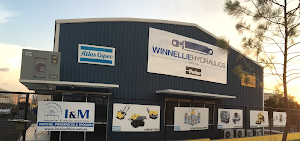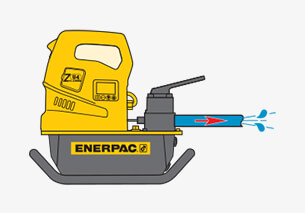
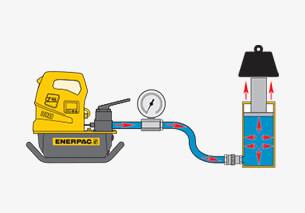
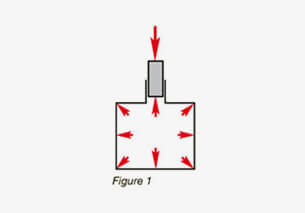
This means that when more than one hydraulic cylinder is being used, each cylinder will lift at its own rate, depending on the force required to move the load at that point (Fig. 2).
Cylinders with the lightest load will move first, and cylinders with the heaviest load will move last (Load A), as long as the cylinders have the same capacity.
To have all cylinders operate uniformly so that the load is being lifted at the same rate at each point, either control valves (see Valve section) or Synchronous Lift System components (see Cylinder section) must be added to the system (Load B).
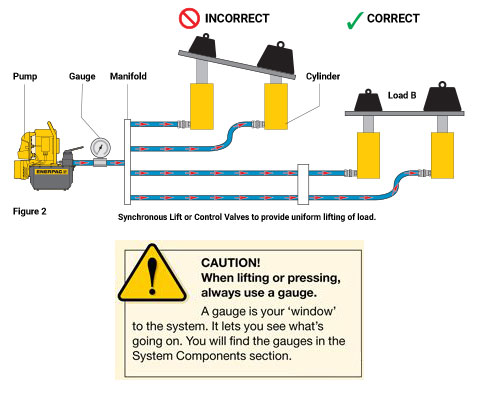
The amount of force a hydraulic cylinder can generate is equal to the hydraulic pressure times the “effective area” of the
cylinder (see cylinder selection charts).
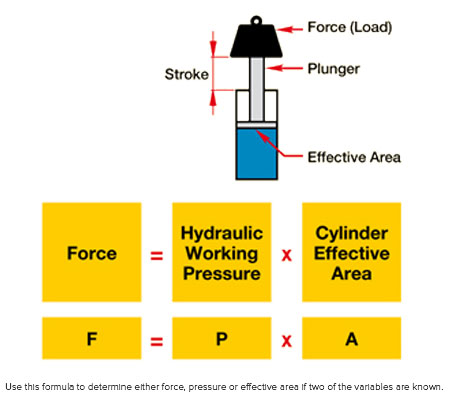
An RC-106 cylinder with 14,5 cm2 effective area operating at 700 bar will generate what force?
Force=7000 N/cm2 x 14,5 cm2=101500 N=101,5 kN
An RC-106 cylinder lifting 7000 kg will require what pressure?
Pressure= 1kg = 1 psi ie 7000kg = 7000psi (or 482 Bar)
An RC-256 cylinder is required to produce a force of 190.000 N. What pressure is required?
Pressure=190.000 N ÷ 33,2 cm2=5722,9 N/cm2=572 bar.
Four RC-308 cylinders each with 6.49 in2 effective area are required to produce a force of 180,000 lbs. What pressure is required?
Pressure= 180,000 lbs ÷ (4 x 6.49 in2)=6933 psi.Remember, since four cylinders are used together, the area for one cylinder must be multiplied by the number of cylinders used.
A CLL-2506 cylinder is going to be used with a power source that is capable of 500 bar. What is the theoretical force available from that cylinder?
Force= 5000 N/cm2 x 366,4 cm2=1.832.000 N=1832 kN
The volume of oil required for a cylinder (cylinder oil capacity) is equal to the effective area of the cylinder
times the stroke*.
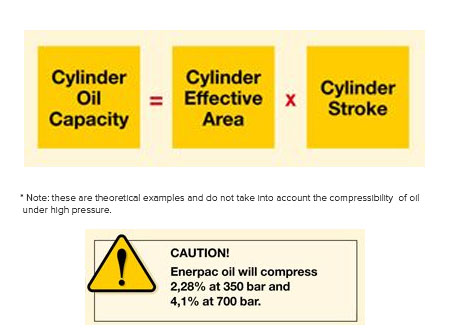
An RC-158 cylinder with 20,3 cm2 effective area and 200 mm stroke requires what volume of oil?
Oil Capacity=20,3 cm2 x 20 cm=406 cm3
An RC-5013 cylinder has an effective area of 71,2 cm2 and a stroke of 320 mm. How much oil will be required?
Oil Capacity =71,2 cm2 x 32 cm=2278,4 cm3
An RC-10010 cylinder has an effective area of 133,3 cm2 and a stroke of 260 mm. How much oil will it require?
Oil Capacity=133,3 cm2 x 26 cm=3466 cm3
Four RC-308 cylinders are being used, each with an effective area of 42,1 cm2 and a stroke of 209 mm. How much oil will be required?
Oil Capacity= 42,1 cm2 x 20,9 cm=880 cm3 for one cylinder. Multiply by four to obtain the required capacity: 3520 cm3
Hydraulic tooling is used for a wide range of functions across a just about every industrial application imaginable during construction, maintenance, shutdown or demobilisation activities onsite. At Winnellie Hydraulics we specialise in the supply, repair, calibration and hire of this equipment to the oil and gas, mining and all other industries.
As a long term, dedicated Enerpac distributor and service centre Winnellie Hydraulics remain committed to providing our valued customers the best tooling, technical support and training to ensure safety, productivity and reliability in your work place.
Should you see value in the information provided, in proud partnership with Enerpac we can conduct Enerpac Safety Training next time we are on your site. Should you like to see more information please get in touch via sales@winnelliehydraulics.com
